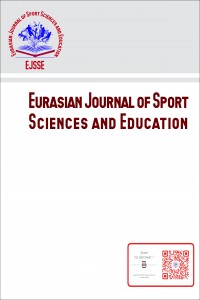Abstract
References
- Cârstea, G.H. (1997). Physical education, theory and basics of methodology. Bucureşti: Ed. Universul. [Cârstea, G. (1997). Educaţia fizică. Teoria şi bazele metodicii. ANEFS.-Bucureşti.].
- Cristea, C. G. (2008).General pedagogy. București: Ed. Didactică și Pedagogică.[Cristea, G. C. (2008). Pedagogie generală. Editura Didactică şi Pedagogică.].
- Cucoş, C. (2000). General pedagogy. Iaşi: Ed. Polirom. [Cucoş, C. (2000). Pedagogie generală. Ed. Polirom, Iaşi.].
- Coates, J., Vickerman, P. (2010). Empowering Children with Special Educational Needs to Speak Up: Experiences of Inclusive Physical Education. Disability and Rehabilitation, 32(18): 1517–1526.
- Dragnea, A., & Teodorescu-Mate S. (2002). The theory of sport, Bucureşti: Ed. Fest. [Dragnea, C. A., & Mate-Teodorescu, S. (2002). Teoria sportului. FEST.].
- Demirci, P. T., Demirci, N. (2018). The effects of game and physıcal actıvıty lessons ın chıldren wıth learnıng dısabılıtıes. Kinesiologia Slovenica, 24, 3, 47–55.
- Fernández Truan J C (2016) Augmentative Communicative Systems in Physical Education for Students with Special Educational Needs. Sports Nutr Ther 1: e101
- Popovici, D.V., (2000).Development of communication in children with mental disabilities, Ed. ProHumanitate, Bucureşti, 309 p.[Popovici, D. V. (2002). Dezvoltarea comunicarii la copiii cu deficiente mintale. Pro Humanitate.].
- Şerbănoiu, S. (2004).Methodology of Physical Education.Bucureşti: Cartea Universitară, [Şerbănoiu, S. (2004). Metodica educaţiei fizice. Bucureşti, Cartea Universitară.].
- Scarlat, E., Scarlat, B., M. (2006). School physical education guide.Bucureşti: Editura didactică şi pedagogică. [Scarlat, E., & Scarlat, M. B. (2006). Îndrumar de educaţie fizică şcolară. Editura Didactică şi Pedagogică.]
- Racu, A., Popovici D.V., &Racu S. (2010).Psychopedagogy of integration,ISFE-P. Chişinău: Tipografia Centrală, [Racu, A., Popovici, D. V., Danii, A., & Racu, S. (2014). Psihopedagogia integrării. Chişinău: Tipografia Centrală, 416.].
- Racu, A., Racu S. (2013).Encyclopaedia dictionary of special psychopedagogy, ISFE-P. Chişinău: Tipografia Centrală. [Racu, A., & Racu, S. (2013). Dicţionar enciclopedic de psihopedagogie specială. Verlag nicht ermittelbar.].
- Radu, G. (2000).Psychopedagogy of mentally handicapped schoolchildren, Ed. Pro Humanitate, Sibiu.[Radu, G. (2000). Psihopedagogia scolarilor cu handicap mintal. Pro Humanitate.]
- Vygotsky, L.S. (1983).Selected psychological works. The basics of defectology.Moscova: Editura ASP, [Opere psihologice alese, vol. V, Bazele defectologiei].
Communication Development in Children With Special Educational Needs Through Game at Physical Education Lessons
Abstract
In various researches,
emphasis is placed on the particular importance of the common game activity in
the peer group for children's learning of verbal means of communication: The
expressions, which are part of the dynamic game, signify the transition from the
situative forms of communication to the non-situative ones. Complicating the
content of verbal contacts is done by broadening the theme of children's
expressions, related to the updating of cognitive representations, personal
preferences and subjective appreciations of communicators. When the game is
used in the educational process, it acquires significant psycho-pedagogical
functions, ensures active participation of the pupil at the lesson, increases
his / her interest for knowledge and the content of the lessons, offers the
organized framework for practicing the communication. In modern society, known
as the society of information and communication, it is surprising that we
continue to limit the capacity of communication to certain parts of the
population such as students with special educational needs. For them,
communication restraints mean an obstacle to the development of their
educational capacities (Fernandez, 2016). The purpose of this study derives
from the complexity of activities involving interaction during Physical
Education lessons. The study focuses on identifying direct or indirect forms of
communication in Physical Education lessons, as well as how they are used and
how they are reflected in specific moments of the lesson structure.
The main research methods include the bibliographic
study, the observation method and some evaluation tests, which form the basis
for the necessary documentation and understanding of the communication process
in association with the physical education (game) activities.
References
- Cârstea, G.H. (1997). Physical education, theory and basics of methodology. Bucureşti: Ed. Universul. [Cârstea, G. (1997). Educaţia fizică. Teoria şi bazele metodicii. ANEFS.-Bucureşti.].
- Cristea, C. G. (2008).General pedagogy. București: Ed. Didactică și Pedagogică.[Cristea, G. C. (2008). Pedagogie generală. Editura Didactică şi Pedagogică.].
- Cucoş, C. (2000). General pedagogy. Iaşi: Ed. Polirom. [Cucoş, C. (2000). Pedagogie generală. Ed. Polirom, Iaşi.].
- Coates, J., Vickerman, P. (2010). Empowering Children with Special Educational Needs to Speak Up: Experiences of Inclusive Physical Education. Disability and Rehabilitation, 32(18): 1517–1526.
- Dragnea, A., & Teodorescu-Mate S. (2002). The theory of sport, Bucureşti: Ed. Fest. [Dragnea, C. A., & Mate-Teodorescu, S. (2002). Teoria sportului. FEST.].
- Demirci, P. T., Demirci, N. (2018). The effects of game and physıcal actıvıty lessons ın chıldren wıth learnıng dısabılıtıes. Kinesiologia Slovenica, 24, 3, 47–55.
- Fernández Truan J C (2016) Augmentative Communicative Systems in Physical Education for Students with Special Educational Needs. Sports Nutr Ther 1: e101
- Popovici, D.V., (2000).Development of communication in children with mental disabilities, Ed. ProHumanitate, Bucureşti, 309 p.[Popovici, D. V. (2002). Dezvoltarea comunicarii la copiii cu deficiente mintale. Pro Humanitate.].
- Şerbănoiu, S. (2004).Methodology of Physical Education.Bucureşti: Cartea Universitară, [Şerbănoiu, S. (2004). Metodica educaţiei fizice. Bucureşti, Cartea Universitară.].
- Scarlat, E., Scarlat, B., M. (2006). School physical education guide.Bucureşti: Editura didactică şi pedagogică. [Scarlat, E., & Scarlat, M. B. (2006). Îndrumar de educaţie fizică şcolară. Editura Didactică şi Pedagogică.]
- Racu, A., Popovici D.V., &Racu S. (2010).Psychopedagogy of integration,ISFE-P. Chişinău: Tipografia Centrală, [Racu, A., Popovici, D. V., Danii, A., & Racu, S. (2014). Psihopedagogia integrării. Chişinău: Tipografia Centrală, 416.].
- Racu, A., Racu S. (2013).Encyclopaedia dictionary of special psychopedagogy, ISFE-P. Chişinău: Tipografia Centrală. [Racu, A., & Racu, S. (2013). Dicţionar enciclopedic de psihopedagogie specială. Verlag nicht ermittelbar.].
- Radu, G. (2000).Psychopedagogy of mentally handicapped schoolchildren, Ed. Pro Humanitate, Sibiu.[Radu, G. (2000). Psihopedagogia scolarilor cu handicap mintal. Pro Humanitate.]
- Vygotsky, L.S. (1983).Selected psychological works. The basics of defectology.Moscova: Editura ASP, [Opere psihologice alese, vol. V, Bazele defectologiei].
Details
| Primary Language | English |
|---|---|
| Subjects | Sports Medicine |
| Journal Section | Articles |
| Authors | |
| Publication Date | June 30, 2019 |
| Acceptance Date | June 27, 2019 |
| Published in Issue | Year 2019 Volume: 1 Issue: 1 |
Cite


